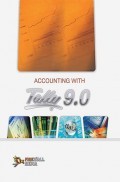About The Book Financial Accounting by S.N. Maheshwari, S.K. Maheshwari & Sharad K. Maheswari
Book Summary:
Financial Accounting provides a comprehensive coverage to course requirements of students appearing in the paper Financial Accounting at BCom, BCom (Hons) examinations of different Indian universities and Foundation Examination (NS) of the Institute of Company Secretaries of India. The book is divided into four sections: Section I explains the fundamental principles necessary for understanding the subject. It covers the entire accounting cycle—from recording of financial transactions to the preparation of final accounts. Section II deals with accounting problems related to certain specific types of business transactions. Section III deals with partnership accounts. Section IV provides suggested answers to recent examinations’ questions.
Audience of the Book :
For BCom, CA, CS and ICWA (Foundation) Courses
Key Features:
The main features of the book are as follows:
1. Comprehensively meets the combined requirements of the students appearing at BCom (Hons) I Yr., CA Foundation and CS Foundation Examinations.
2. Written in simple and straight style.
3. Gives a lucid explanation of the basic concepts of accounting with plenty of illustrative material.
4. The subject matter has been presented in a manner that even a student who has not studied Accountancy at ‘10 + 2 level’ can easily understand and have a grasp over the subject.
5. Incorporates at the end of each chapter :
• objective type questions with short answers to enable the students to test their understanding,
• essay type questions for review, discussion and practice, and
• practical problems with short answers for practice to develop a sense of confidence amongst the students.
6. Provides Learning Objectives at the beginning of each chapter to tell the students what they will learn after studying the chapter.
7. Defines Key Terms at the end of each chapter for recapitulation and better grasp over the subject.
Table of Contents:
Unit I:
-
Basic Concepts and Conventions, Accounting Standards:Meaning, Significance, Generally Accepted Accounting Principles (GAAP)
-
Accounting Process: From recording of transactions to preparation of final accounts.
-
Final Accounts of Not-for-profit Organization: From receipts and payments account with additional information and vice-versa. Preparation of Balance Sheets (opening and closing) from Receipts and Payments Account and Income Expenditure Account and additional information.
Unit II:
4. Consignments: Features, Accounting treatment in the books of the consignor and consignee.
5. Joint Ventures: Accounting procedures: Joint Bank Account, Records maintained by co-venturer of (a) all transactions (b) only his own transactions. (Memorandum joint venture account)
Unit III:
6.Depreciation Accounting: Meaning of depreciation, causes,objects of providing depreciation, factors affecting depreciation,accounting treatment including provision for depreciation accounting.Methods of depreciation: Straight line method, Diminishing balance method, Change of method as per revised AS-6.
7.Accounting for Hire Purchase Transactions, Journal entries and Ledger accounts in the books of Hire Vendors and Hire Purchaser for large value items including default and repossession.
Unit IV:
8.Inland Branches: Dependent branches only and Ascertainment of Profit by Debtors method and Stock and Debtors method.
9.Dissolution of Partnership Firms: Legal position, Accounting for simple dissolution, Applications of rule in case of Garner vs Murray in case of insolvency of partner(s) (excluding piecemeal distribution and sale of a firm to a company).






























